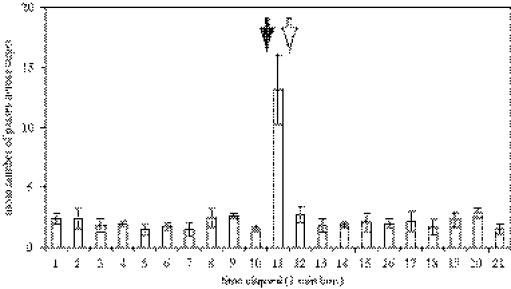Sharks can detect changes in the geomagnetic field (original) (raw)
Abstract
We used behavioural conditioning to demonstrate that sharks can detect changes in the geomagnetic field. Captive sharks were conditioned by pairing activation of an artificial magnetic field with presentation of food over a target. Conditioned sharks subsequently converged on the target when the artificial magnetic field was activated but no food reward was presented thereby demonstrating that they were able to sense the altered magnetic field. This strong response provides a robust behavioural assay that could be used to determine how sharks detect magnetic fields and to measure detection thresholds.
Keywords: elasmobranch, compass sense, magnetoreception
Sharks are widely thought to use the earth's magnetic field for navigation but most evidence for this putative compass sense is circumstantial. For example, tiger sharks (_Galeocerdo cuvier_—Holland et al. 1999), blue sharks (_Prionace glauca_—Carey & Scharold 1990) and scalloped hammerhead sharks (_Sphyrna lewini_—Klimley 1993) can swim in straight lines for long periods across open ocean, and the latter orient to seamounts where geomagnetic anomalies exist (Klimley 1993). Captive studies have demonstrated that sessile stingrays orient to electric fields similar to those produced by ocean currents moving through the earth's magnetic field (Kalmijn 1982) but to date, there is no empirical evidence that sharks can detect magnetic fields per se. We used behavioural conditioning to demonstrate that sharks can detect changes in the geomagnetic field.
Six sandbar sharks (Carcharhinus plumbeus) and one scalloped hammerhead shark were housed in a 7-m diameter tank surrounded by an 8-m diameter coil consisting of 100 turns of 18 AWG copper wire. Supplying power (13.8 VDC, 1.5 A) to the coil produced a vertical magnetic field inside the tank with a total field strength ranging from 100 μT at the perimeter to 25 μT at the centre. Ambient magnetic field intensity was 36 μT. Therefore, the altered field was between 0.7 and 2.8 times the total intensity of earth's magnetic field in Hawaii. Sharks were conditioned by pairing activation of the artificial magnetic field with presentation of food at a 1.5×1.5 m2 target marked on the tank floor. Following conditioning, the behavioural bioassay compared the number of times sharks entered the target (feeding) area under normal magnetic field conditions with the number of passes through the target when the artificial field was activated. Responses were recorded by a video camera suspended above the target area. Each trial consisted of a 21 min observation period; 10 min before turning the field on, 1 min with the artificial field on and 10 min after turning the field off. Eleven trials were conducted over a six week period. No food was presented during experimental trials but conditioning was reinforced between experiments. To preclude erroneous conditioning to extraneous cues, the DC power supply unit was physically isolated from the test tank and scientific personnel were not visible to the sharks in the tank. All experiments were approved by the University of Hawaii Institutional Animal Care Advisory Committee.
Activating the artificial field produced an immediate response in the conditioned sharks. They changed from swimming steadily around the perimeter of the tank to swimming faster, turning rapidly and converging on the target in anticipation of a food reward. This change in behaviour resulted in significantly more passes over the target with the artificial field on than off (ANOVA, _F_2,10=57.4, p<0.001) (figure 1). The conditioned sharks were clearly able to sense the altered magnetic field. Candidate systems mediating this response include magnetite-based receptors (Walker et al. 1997), magnetically sensitive chemical reactions (Ritz et al. 2004), or the shark electroreceptive system (Kalmijn 1982; Paulin 1995) (or a combination of these). Unequivocal behavioural responses to earth-strength magnetic stimuli have proven elusive in most other animals (Couvillon et al. 1992) but the strong response shown by the captive sharks provides a robust behavioural assay that can now be used to precisely determine how sharks detect magnetic fields and to measure detection thresholds.
Figure 1.
Mean number of passes per minute by sharks across a 1.5×1.5 m2 target during the 21 min duration of magnetoreception experiments. Means for each 1 min bin are derived from 11 trials. Error bars are 1 s.e.m. Shaded arrow, artificial magnetic field activated; unshaded arrow, artificial field turned off.
References
- Carey F.G, Scharold J.V. Movements of blue sharks in depth and course. Mar. Biol. 1990;106:329–342. [Google Scholar]
- Couvillon P.A, Asam A.M, Bitterman M.E. Further efforts at training pigeons to discriminate changes in the geomagnetic field. J. Exp. Biol. 1992;173:295–299. doi: 10.1242/jeb.173.1.295. [DOI] [PubMed] [Google Scholar]
- Holland K.N, Wetherbee B.M, Lowe C.G, Meyer C.G. Movements of tiger sharks (Galeocerdo cuvier) in coastal Hawaiian waters. Mar. Biol. 1999;134:665–673. [Google Scholar]
- Kalmijn A.J. Electric and magnetic field detection in elasmobranch fishes. Science. 1982;218:916–918. doi: 10.1126/science.7134985. [DOI] [PubMed] [Google Scholar]
- Klimley A.P. Highly directional swimming by scalloped hammerhead sharks, Sphyrna lewini, and subsurface irradiance, temperature, bathymetry, and geomagnetic field. Mar. Biol. 1993;117:1–22. [Google Scholar]
- Paulin M.G. Electroreception and the compass sense of sharks. J. Theor. Biol. 1995;174:325–339. [Google Scholar]
- Ritz T, Thalau P, Phillips J.B, Wiltschko R, Wiltschko W. Resonance effects indicate a radical-pair mechanism for avian magnetic compass. Nature. 2004;429:177–180. doi: 10.1038/nature02534. [DOI] [PubMed] [Google Scholar]
- Walker M.M, Diebel C.E, Haugh C.V, Pankhurst P.M, Montgomery J.C, Green C.R. Structure and function of the vertebrate magnetic sense. Nature. 1997;390:371–376. doi: 10.1038/37057. [DOI] [PubMed] [Google Scholar]
